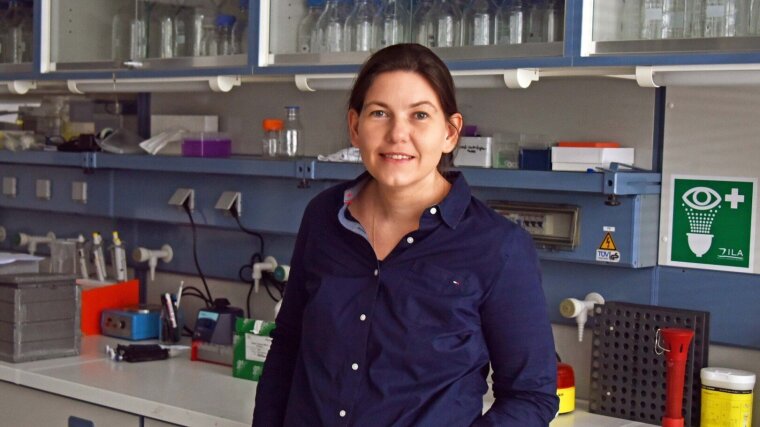
- Life
- Research
Published: | By: Marco Körner
The ordered areas of proteins are readily studied. Consequently, a great deal is known about the role of these areas in the biological function of the respective proteins. However, an international research team led by biochemist Prof. Dr Ute Hellmich has shown that disordered areas are also pivotal. Their comprehensive examination of the disordered area of a receptor channel protein has been published in the renowned scientific journal “Nature Communications.” The group demonstrated through eleven different methods how this area influences the function of the entire protein. Therefore, disordered protein areas should not be overlooked in research, even though they may not always be straightforward to investigate.
Investigating disorder in proteins
Proteins play a part in all processes of life. They facilitate the reading and duplication of genetic material, digest nutrients and carry out countless other essential functions. These large protein molecules can be best researched when they have a clear structure - that is, when the individual areas within the molecules are ordered. “Classically, these proteins would be examined using X-ray crystallography or cryo-electron microscopy. But these methods are most suited for regular, or ordered, structures,” explains Hellmich. “For this reason, in some studies the disordered areas are intentionally removed to better examine the remaining molecule. But if you are specifically interested in that area, that is of course not an option.”
Hellmich and her team specifically studied a very large, disordered area of the receptor channel protein TRPV4. “So-called Transient Receptor Potential Channels, which include TRPV4, control our perception of pain and temperature and play a crucial role in the immune system and during infections,” Hellmich elucidates her research subject. “There are more than 60 known mutants of TRPV4 that cause serious illnesses. This clearly indicates how significant these proteins are,” she adds. “In some representatives of this protein class, the disordered area comprises half of the entire molecule. This alone demonstrates that these domains cannot be overlooked,” continues the biochemist. The TRPV4 protein that her team studied has one of the largest disordered areas of this protein class in mammals, specifically containing about 130 to 150 individual amino acids. If you cut off this disordered area, TRPV4 loses its function.
A multidisciplinary perspective
In their work, the researchers used a total of eleven different biochemical and biophysical methods in various combinations – from nuclear magnetic resonance spectroscopy to mass spectrometry to molecular dynamic simulations. “At some points, we pursued a research question with different methods at the same time. We simply wanted to be quite certain that we understand the receptor correctly,” explains Hellmich. This approach enabled us to create a molecular map of this disordered area. Thus, we discovered a network of various activity-determining elements that activate or deactivate the receptor depending on the chemical environment.
“When you consider that these disordered areas of receptor channel proteins have not been viewed in this way before, our research work certainly opens a completely new perspective on protein research and the biological function and regulation of receptors by their disordered areas,” Hellmich classifies the result. “Whether it might even be a paradigm shift, we will likely see in the coming years. I am confident that our further work within the framework of the ‘Balance of the Microverse’ excellence cluster here at the university will contribute to this,” says the scientist.
Collaboration and support at the highest level
Hellmich is particularly grateful for the successful international collaboration that made this work possible: “My team was greatly supported by colleagues at Johns Hopkins University, the Max Planck Institute for Biophysics in Frankfurt am Main, the University of Konstanz, the University of Marburg, and the European Molecular Biology Laboratory (EMBL)/German Electron Synchrotron (DESY). I would especially like to thank my talented PhD student Benedikt Goretzki, who, with support from my team, significantly propelled the project forward.”
Ute Hellmich is also grateful for the financial and collaborative support from the Cluster of Excellence “Balance of the Microverse” and the Collaborative Research Centre 1507 “Protein Assemblies and Machineries in Cell Membranes”, funded by the German Research Foundation and the European Regional Development Fund (ERDF), REACT-EU within the framework of the specialization field “Healthy Living and Health Economy” of the RIS3 strategy of the state of Thuringia for the purchase of a high-field nuclear magnetic resonance spectrometerExternal link.
Original publication:
Benedikt Goretzki, Christoph Wiedemann, Brett A. McCray, Stefan L. Schäfer, Jasmin Jansen, Frederike Tebbe, Sarah-Ana Mitrovic, Julia Nöth, Ainara Claveras Cabezudo, Jack K. Donohue, Cy M. Jeffries, Wieland Steinchen, Florian Stengel, Charlotte J. Sumner, Gerhard Hummer & Ute A. Hellmich: "Crosstalk between regulatory elements in disordered TRPV4 N-terminus modulates lipid-dependent channel activity", Nature Communications, 14, 4165 (2023). DOI: 10.1038/s41467-023-39808-4External link
Kontakt:

07743 Jena Google Maps site planExternal link